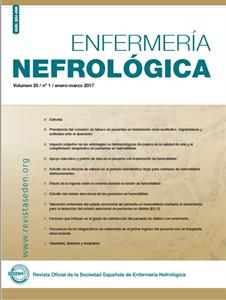Contenido del artículo principal
Resumen
Introducción: Las alteraciones psicológicas y emocionales influyen en el estado bio-psico-social del paciente en hemodiálisis. Un mejor conocimiento de estos aspectos nos ayuda a la comprensión y al manejo de las situaciones difíciles en su día a día.
Objetivos: Con este estudio se describe el estado emocional de los pacientes en hemodiálisis por medio del cuestionario EE-D, aplicado por profesionales de enfermería y analizaremos si existe relación entre éste y otras variables individuales.
Metodología: Se realizó un estudio descriptivo de corte trasversal, a 84 pacientes en hemodiálisis. Se utilizó el cuestionario EE-D, donde se valora la tristeza y el nerviosismo percibido por el paciente en la última semana, sus preocupaciones en diferentes ámbitos y que motivaciones encuentra para sentirse mejor o ilusionarse. Se recopilaron en un cuestionario ad hoc, datos demográficos, laborales, de adhesión al tratamiento farmacológico, etc.
Resultados: En el parámetro tristeza obtuvimos una media de 3.8 (0 nada y 10 máxima), la moda fue 0 y un 73.8% obtuvo un nivel igual o inferior a 5. En cuanto al nerviosismo, la media fue 3, la moda 0 y el 79.8% manifestaron un nivel igual o inferior a 5.
En cuanto a las preocupaciones casi la mitad de los pacientes refirió tener preocupaciones relacionadas con el ámbito familiar y con su enfermedad o tratamiento, seguido por el ámbito emocional, laboral y religioso respectivamente.
Conclusiones: Nuestros pacientes presentan niveles bajos de tristeza, medios en cuanto a sus preocupaciones relacionadas con su enfermedad, mostrando en su mayoría facilidad para ilusionarse al encontrar motivaciones para ello.
Objetivos: Con este estudio se describe el estado emocional de los pacientes en hemodiálisis por medio del cuestionario EE-D, aplicado por profesionales de enfermería y analizaremos si existe relación entre éste y otras variables individuales.
Metodología: Se realizó un estudio descriptivo de corte trasversal, a 84 pacientes en hemodiálisis. Se utilizó el cuestionario EE-D, donde se valora la tristeza y el nerviosismo percibido por el paciente en la última semana, sus preocupaciones en diferentes ámbitos y que motivaciones encuentra para sentirse mejor o ilusionarse. Se recopilaron en un cuestionario ad hoc, datos demográficos, laborales, de adhesión al tratamiento farmacológico, etc.
Resultados: En el parámetro tristeza obtuvimos una media de 3.8 (0 nada y 10 máxima), la moda fue 0 y un 73.8% obtuvo un nivel igual o inferior a 5. En cuanto al nerviosismo, la media fue 3, la moda 0 y el 79.8% manifestaron un nivel igual o inferior a 5.
En cuanto a las preocupaciones casi la mitad de los pacientes refirió tener preocupaciones relacionadas con el ámbito familiar y con su enfermedad o tratamiento, seguido por el ámbito emocional, laboral y religioso respectivamente.
Conclusiones: Nuestros pacientes presentan niveles bajos de tristeza, medios en cuanto a sus preocupaciones relacionadas con su enfermedad, mostrando en su mayoría facilidad para ilusionarse al encontrar motivaciones para ello.
Palabras clave
ALTERACIONES PSICOLÓGICAS
ESTADO EMOCIONAL
HEMODIÁLISIS
HERRAMIENTA ENFERMERÍA
Detalles del artículo
Licencia
Aviso de derechos de autor/a
© Los autores ceden de forma no exclusiva los derechos de explotación de los trabajos publicados y consiente en que su uso y distribución se realice con la Licencia Creative Commons Atribución - No comercial 4.0 Internacional (CC BY-NC 4.0). Puede consultar desde aquí la versión informativa y el texto legal de la licencia. Esta circunstancia ha de hacerse constar expresamente de esta forma cuando sea necesario.
Cómo citar
1.
Olmedo Moreno N, Sánchez Izquierdo FL, Urbón Peláez N, Rico González A, Abad Lambert M de la C, González Miñano J. Valoración enfermera del estado emocional del paciente en hemodiálisis mediante la herramienta para la detección del estado emocional de pacientes en diálisis (EE-D). Enferm Nefrol [Internet]. 2017 [consultado 19 Dic 2025];20(1):[aprox. 7 p.]. Disponible en: https://www.enfermerianefrologica.com/revista/article/view/4049




